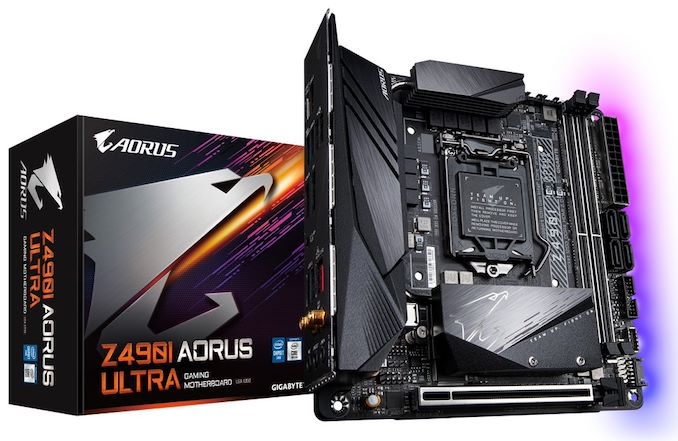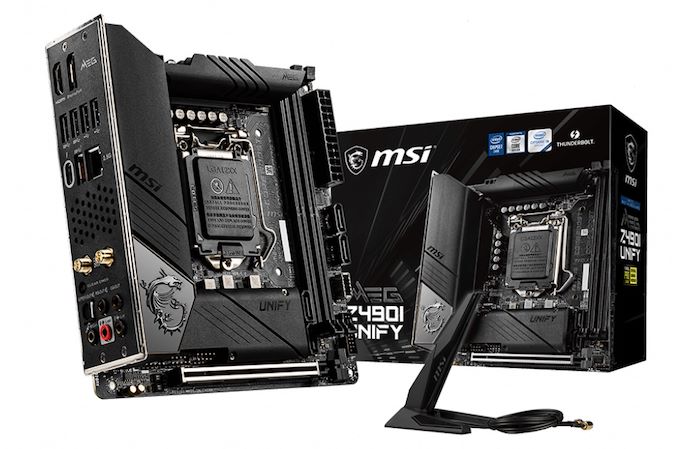The Z490 Mini-ITX Showdown: GIGABYTE's Z490I Aorus Ultra and MSI's MEG Z490I Unify Reviewed
by Gavin Bonshor on August 4, 2020 10:30 AM ESTAorus Versus Unify, Z490 Mini-ITX at $270
When it comes to building a high-performance, small form factor Intel system, the market for motherboards remains a unique one. The integration and tight engineering tolerances means that there are fewer boards, and what boards we do get tend to carry a price premium, but at the end of the day mini-ITX boards are irreplaceable from a size standpoint.
On paper, both the GIGABYTE Z490I Aorus Ultra and MSI MEG Z490I Unify are quite similar in regards to features, with much of the same functionality for identical price tags, though the MSI Z490I Unify does include a Thunderbolt 3 controller, which helps it stand out.
GIGABYTE Z490I Aorus Ultra
The GIGABYTE Z490I Aorus Ultra is the company's only mini-ITX model at present, and it occupies a firm position in the mid-range of its product stack. It is essentially a smaller version of its ATX form factor Z490 Aorus Ultra, with similar stylings and a condensed feature set that is influenced by the mini-ITX form factor. It has plenty of features including a good selection of USB ports on the rear, including seven Type-A ports and one Type-C port, as well as a pair of video outputs for users looking to leverage Intel's integrated UHD graphics. This also includes three 3.5 mm audio jacks powered by the Realtek ALC1220 HD audio codec, though this is noticeably condensed from the typical five 3.5 mm and S/PDIF array.
Other features include a single Intel I225-V 2.5 GbE Ethernet controller and a AX201 Wi-Fi 6 controller, which is standard for $250+ Z490 boards. Meanwhile on the CPU and memory front, we're looking at two DIMM slots for a maximum of 64 GB of memory, while the CPU is used to drive the board's single full-length PCIe 3.0 x166 slot. Overall, in many ways the Z490I Aorus Ultra is the quintessential mid-range motherboard, offering a very solid feature set in a board that's otherwise going to stand out more for its size than its functionality.
Looking at the aesthetics, GIGABYTE opts for a more stylish black and silver contrasting theme, with much of PCB covered by, componentry, traces, and heatsinks, in which GIGABYTE has effectively used all of the available space. One interesting thing to note is that GIGABYTE has opted to use its own fan connectors and provide adapters within the accessories bundle, which has allowed them to fit in an extra 4-pin fan connector when compared to the MSI model. GIGABYTE has even managed to fit in a USB 3.2 G2 Type-C front panel header, which is likely to further increase the overall cost of the system, yet it's still a welcomed feature to include as Type-C ports become more common on computer cases.
In our testing, the GIGABYTE Z490I Aorus Ultra was very competitive with the other Z490 boards in our test suite, showcasing solid performance in our system tests, while power consumption at full-load was the lowest power figure we've seen to date. It also performs well in our CPU and game testing, while scoring a big win in our power delivery system thermal testing, besting several other Z490 boards in the process. This is a bigger feat than it sounds, as mini-ITX models generally run hotter due to the condensed PCB space and closer components; but the Z490I Aorus Ultra manages well. Even in our overclocking testing, the GIGABYTE board managed to max out our chip at 5.3 GHz, despite obvious thermal throttling issues, and breezed through our settings at 5.2 GHz making it a solid board for enthusiasts looking for a good performing small form factor system.
MSI MEG Z490I Unify
The MSI MEG Z490I Unify is part of MIS's enthusiast gaming stack, which is generally reserved for its top boards. When MSI first announced it was creating a mini-ITX version of its popular Unify series, there was a lot of fanfare surrounding the performance, capabilities, as well as the componentry used. In regards to the specifications, MSI didn't disappoint with its 10-layer PCB and powerful 9-phase power delivery system, with the inclusion of an Intel Thunderbolt 3 controller also positively raising eyebrows.
Much of the board's appeal comes from its subtle monotonal all-black design, which opts to omit any form of integrated RGB lighting. This is a selling point as far as MSI is concerned, as the majority of its models are RGB-infused and focus on multiple areas of customizable LEDs to create a very vibrant and personal system. So the Unify board offers something different, if only by virtue of taking something away.
With regards to features, the MSI Z490I Unify includes plenty of things to talk about, including the aforementioned Thunderbolt 3 controller, a USB 3.2 G2 Type-C front panel header, as well as two PCIe 3.0 x4 M.2 slots and four SATA ports with support for RAID 0, 1, 5, and 10 arrays.
Focusing on the performance, the Unify showed great performance in our system tests with the fastest POST time from any Z490 model we've tested so far. But that speed also leaves the board in a bit of a hurry to draw power in general, and as a result our power consumption figures were higher than what we've seen for other Z490 boards, including the GIGABYTE board. Otherwise we noticed no anomalies in our CPU and game testing, and the board was very competitive against other Z490 boards. In our overclock testing, we were a little disappointed that we couldn't reach our peak frequency of 5.3 GHz on our testbed Core i7-10700K processor, while the power delivery system ran a bit hot despite the inclusion of a small cooling fan to help keep these temperatures lower.
On paper, the power delivery system and overall feature set put the MSI MEG Z490I Unify ahead of most boards in its price range. Overall, it's a good implementation of the Unify series on a small form factor board, especially as this is MSI's first mini-ITX Unify. It also gives MSI a good platform to refine for later models and refreshes (e.g. Rocket Lake), and we expect MSI will make the Unify series one of its premier series going forward.
Final Words
When comparing the MSI MEG Z490I Unify and GIGABYTE Z490I Aorus Ultra against each other, both have their strengths and weaknesses. MSI's board offers a stronger feature set with Thunderbolt 3 compatibility out of the box, as well as a pleasing design style that looks neat and simple. Both the MSI and GIGABYTE use similar 10-layer PCB's and power delivery systems, which should on paper, make them both attractive for users at the $270 price point. Both include dual PCIe 3.0 x4 M.2 slots, four SATA ports, support for 64 GB of DDR4-5000, 2.5 GbE Ethernet, and Wi-Fi 6 capability, further reinforcing these similarities. But the boards do eventually diverge at a couple of aspects.
If overclocking and power delivery system cooling are the top considerations, our testing shows the GIGABYTE to be the superior model, thanks in part to a better heatsink implementation than MSI's board. GIGABYTE also offers integrated RGB LEDs, which used sensibly can add a degree of customization to the board's overall aesthetic. Conversely, the Unify noticeably forgoes those RGBs LEDs, and instead focuses on a few extra features such as Thunderbolt support.
Overall, I feel that MSI's Unify board has the edge in aesthetics. But when it comes to performance – particularly overclocked performance – GIGABYTE's Aorus Ultra is a slightly more attractive option. MSI's cooling system isn't quite as hearty under extreme workloads, and a better heatsink probably would have been more effective than the miniature cooling fan MSI used. However if you're not overclocking, then it's hard to ignore the MSI's inclusion of a Thunderbolt 3 controller, which gives the board a definite edge in features.












21 Comments
View All Comments
realbabilu - Tuesday, August 4, 2020 - link
Max fan size?Mr Perfect - Tuesday, August 4, 2020 - link
So the MSI trades two USB 3 ports for a weedy little VRM fan that doesn't beat a passively cooled board? A poor trade.nerd1 - Tuesday, August 4, 2020 - link
Single GBE for $270 board?shabby - Tuesday, August 4, 2020 - link
Less is more...drexnx - Tuesday, August 4, 2020 - link
no space on the PCB or back panel for moree1jones - Tuesday, August 4, 2020 - link
Don't they both have a single 2.5G connector?Luminar - Tuesday, August 4, 2020 - link
I would only buy with 10G ethernet.firewrath9 - Wednesday, August 5, 2020 - link
I would only buy with 400gbe infinibandAdditionalPylons - Wednesday, August 5, 2020 - link
At least 2.5 GbE is finally becoming standard with this generation of motherboards!Personally, on bigger boards I don't mind the integrated NIC because I can easily add a 25 GbE SFP28 PCIe card for less than $100 used (or 10 GbE SFP+ for ~$30).
On smaller boards like mITX however, with only one PCIe slot available, I would also prefer 10 GbE integrated.
Of course these are personal preferences. I don't see 10GbE ever going mainstream because the need simply isn't there for the vast majority of people. Even most tech geeks at AT and similar sites are still fine with 1 GbE (or slower wifi). Also, because we who want faster don't mind different cables and connectors (SFP+) and therefore can buy cheap used enterprise gear, there is simply a very small market left.
On a related note, while switches are getting cheaper (e.g. Netgear MS510TX, QNAP QSW-308-1C / QSW-1105T, Mikrotik CRS305 etc.) it would be nice to see some cheaper 5/10G external USB NIC options to cater to the laptop crowd. ($79 5GbE QNAP QNA-UC5G1T is getting close, but 10G options are all $150+.)
henkhilti - Tuesday, August 4, 2020 - link
Identical vrm components, both have proper vrm heatsinks.One vrm runs hotter and that board consumes more power (and has hotter cpu).
Better check what the real Vcore voltage is during load with a multimeter on the back of the cpu socket and you will know why!!!!
Always check real voltages with a multimeter when overclocking. Use Loadline calibration settings in bios (with more Vdroop) to increase stability (during transients).
If both boards run identical Vcore during load, power consumption and cpu heat will be very similar.